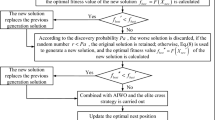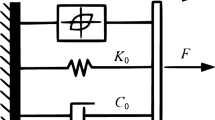Abstract
A developed comparative analysis of metaheuristic optimization algorithms has been used for optimal active control of structures. The linear quadratic regulator (LQR) has ignored the external excitation in solving the Riccati equation with no sufficient optimal results. To enhance the efficiency of LQR and overcome the non-optimality problem, six intelligent optimization methods including BAT, BEE, differential evolution, firefly, harmony search and imperialist competitive algorithm have been discretely added to wavelet-based LQR to seek the attained optimum feedback gains. The proposed approach has not required the solution of Riccati equation enabling the excitation effect in controlling process. Employing this advantage by each of six mentioned algorithms to three-story and eight-story structures under different earthquakes led to define (1) the best solution, (2) convergence rate and (3) computational effort of all methods. The purpose of this research is to study the aforementioned methods besides the superiority of ICA in finding the optimal responses for active control problem. Numerical simulations have confirmed that the proposed controller is enabling to significantly reduce the structural responses using less control energy compared to LQR.
























Similar content being viewed by others
References
Ali Toghroli et al (2014) Prediction of shear capacity of channel shear connectors using the ANFIS model. Steel Compos Struct 17(5):623–639
Safa M et al (2016) Potential of adaptive neuro fuzzy inference system for evaluating the factors affecting steel-concrete composite beam’s shear strength. Steel Compos Struct Int J 21(3):679–688
Mohammadhassani M et al (2015) Fuzzy modelling approach for shear strength prediction of RC deep beams. Smart Struct Syst 16(3):497–519
Mansouri I et al (2017) Analysis of influential factors for predicting the shear strength of a V-shaped angle shear connector in composite beams using an adaptive neuro-fuzzy technique. J Intell Manuf 1–11
Toghroli A (2015) Applications of the ANFIS and LR models in the prediction of shear connection in composite beams. Jabatan Kejuruteraan Awam, Fakulti Kejuruteraan, Universiti Malaya
Aghakhani M et al (2015) A simple modification of homotopy perturbation method for the solution of Blasius equation in semi-infinite domains. Math Prob Eng 2015:7
Toghroli A et al (2016) Potential of soft computing approach for evaluating the factors affecting the capacity of steel–concrete composite beam. J Intell Manuf 29:1–9
Sadeghipour Chahnasir E et al (2018) Application of support vector machine with firefly algorithm for investigation of the factors affecting the shear strength of angle shear connectors. Smart Struct Syst 22(4):413–424
Safa M et al (2016) Potential of adaptive neuro fuzzy inference system for evaluating the factors affecting steel–concrete composite beam’s shear strength. Steel Compos Struct 21(3):679–688
Mansouri I et al (2016) Strength prediction of rotary brace damper using MLR and MARS. Struct Eng Mech 60(3):471–488
Toghroli A et al (2018) Evaluation of the parameters affecting the Schmidt rebound hammer reading using ANFIS method. Comput Concr 21(5):525–530
Sari PA, et al (2018) An intelligent based-model role to simulate the factor of safe slope by support vector regression. Eng Comput
Sedghi Y et al (2018) Application of ANFIS technique on performance of C and L shaped angle shear connectors. Smart Struct Syst 22(3):335–340
Shariat M, Shariati M (2018) Computational Lagrangian multiplier method by using for optimization and sensitivity analysis of rectangular reinforced concrete beams. Steel Compos Struct 29:243–256
Grandhi RV (1990) Optimum design of space structures with active and passive damping. Eng Comput 6(3):177–183
Hadi MN, Uz ME (2015) Investigating the optimal passive and active vibration controls of adjacent buildings based on performance indices using genetic algorithms. Eng Optim 47(2):265–286
Amini F, Tavassoli MR (2005) Optimal structural active control force, number and placement of controllers. Eng Struct 27(9):1306–1316
Datta T (2003) A state-of-the-art review on active control of structures. ISET J Earthq Technol 40(1):1–17
Elseaidy WM, Baugh JW, Cleaveland R (1996) Verification of an active control system using temporal process algebra. Eng Comput 12(1):46–61
Liu J, Wang Y (2008) Design approach of weighting matrices for LQR based on multi-objective evolution algorithm. In: 2008 International conference on information and automation (ICIA). IEEE, Changsha, China, pp 1188–1192
Wang W et al (2012) Weight optimization for LQG controller based on the artificial bee colony algorithm. AASRI Procedia 3:686–693
Wang H, et al (2013) Optimization of LQR controller for inverted pendulum system with artificial bee colony algorithm. In: Proceedings of the 2013 international conference on advanced mechatronic systems 2013. IEEE, Louyang, China, pp 158–162
Bottura CP, da Fonseca Neto J (1999) Parallel eigenstructure assignment via LQR design and genetic algorithms. In: Proceedings of the 1999 American control conference. IEEE, San Diego, CA, USA
Bottura CP, da Fonseca Neto JV (2000) Rule-based decision-making unit for eigenstructure assignment via parallel genetic algorithm and LQR designs. In: Proceedings of the 2000 American control conference. IEEE, Chicago, IL, USA
Shen P (2014) Application of genetic algorithm optimization LQR weighting matrices control inverted pendulum. Appl Mech Mater 543–547:1274–1277
Joghataie A, Mohebbi M (2012) Optimal control of nonlinear frames by Newmark and distributed genetic algorithms. Structl Des Tall Spec Build 21(2):77–95
Petković D, Ćojbašič Ž, Nikolić V (2013) Adaptive neuro-fuzzy approach for wind turbine power coefficient estimation. Renew Sustain Energy Rev 28:191–195
Petković D et al (2014) Adaptive neuro-fuzzy maximal power extraction of wind turbine with continuously variable transmission. Energy 64:868–874
Petković D et al (2014) Adapting project management method and ANFIS strategy for variables selection and analyzing wind turbine wake effect. Nat Hazards 74(2):463–475
Nikoli V et al (2017) Wind speed parameters sensitivity analysis based on fractals and neuro-fuzzy selection technique. Knowl Inf Syst 52(1):255–265
Petković D, Pavlović NT, Ćojbašić Ž (2016) Wind farm efficiency by adaptive neuro-fuzzy strategy. Int J Electr Power Energy Syst 81:215–221
Bishop J, Striz A (2004) On using genetic algorithms for optimum damper placement in space trusses. Struct Multidiscip Optim 28(2–3):136–145
Singh MP, Moreschi LM (2002) Optimal placement of dampers for passive response control. Earthq Eng Struct Dyn 31(4):955–976
Cha Y-J et al (2012) Multi-objective genetic algorithms for cost-effective distributions of actuators and sensors in large structures. Expert Syst Appl 39(9):7822–7833
Amini F, Hazaveh NK, Rad AA (2013) Wavelet PSO-based LQR algorithm for optimal structural control using active tuned mass dampers. Comput-Aid Civ Infrastruct Eng 28(7):542–557
Aghajanian S et al (2014) Optimal control of steel structures by improved particle swarm. Int J Steel Struct 14(2):223–230
Amini F, Ghaderi P (2012) Optimal locations for MR dampers in civil structures using improved Ant Colony algorithm. Opt Control Appl Methods 33(2):232–248
Bekdaş G, Nigdeli SM (2011) Estimating optimum parameters of tuned mass dampers using harmony search. Eng Struct 33(9):2716–2723
Amini F, Ghaderi P (2013) Hybridization of harmony search and ant colony optimization for optimal locating of structural dampers. Appl Soft Comput 13(5):2272–2280
Aydin E (2012) Optimal damper placement based on base moment in steel building frames. J Constr Steel Res 79:216–225
Mohebbi M, Joghataie A (2012) Designing optimal tuned mass dampers for nonlinear frames by distributed genetic algorithms. Struct Des Tall Spec Build 21(1):57–76
Zarbaf SEHAM et al (2017) Stay cable tension estimation of cable-stayed bridges using genetic algorithm and particle swarm optimization. J Bridge Eng 22(10):05017008
Chen X et al (2018) Prediction of shear strength for squat RC walls using a hybrid ANN–PSO model. Eng Comput 34(2):367–383
Tian H, Shu J, Han L (2018) The effect of ICA and PSO on ANN results in approximating elasticity modulus of rock material. Eng Comput 35:1–10
Sierra MR, Coello CAC (2005) Improving PSO-based multi-objective optimization using crowding, mutation and ∈-dominance. In: International conference on evolutionary multi-criterion optimization. Springer, New York
Leung A, Zhang H (2009) Particle swarm optimization of tuned mass dampers. Eng Struct 31(3):715–728
Özsarıyıldız ŞS, Bozer A (2015) Finding optimal parameters of tuned mass dampers. Struct Des Tall Spec Build 24(6):461–475
Bagheri A, Amini F (2013) Control of structures under uniform hazard earthquake excitation via wavelet analysis and pattern search method. Struct Control Health Monit 20(5):671–685
Amini F, Bagheri A (2014) Optimal control of structures under earthquake excitation based on the colonial competitive algorithm. Struct Des Tall Spec Build 23(7):500–511
Gandomi AH, Yang X-S, Alavi AH (2013) Cuckoo search algorithm: a metaheuristic approach to solve structural optimization problems. Eng Comput 29(1):17–35
Yang X-S (2010) A new metaheuristic bat-inspired algorithm. In: Nature inspired cooperative strategies for optimization (NICSO 2010). Springer, New York, pp 65–74
Varaee H, Ghasemi MR (2017) Engineering optimization based on ideal gas molecular movement algorithm. Eng Comput 33(1):71–93
Ghasemi MR, Varaee H (2017) A fast multi-objective optimization using an efficient ideal gas molecular moment algorithm. Eng Comput 33(3):477–496
Gendreau M, Potvin J-Y (2010) Handbook of metaheuristics, vol 2. Springer, New York
Yang X-S (2013) Multiobjective firefly algorithm for continuous optimization. Eng Comput 29(2):175–184
Ohtori Y et al (2004) Benchmark control problems for seismically excited nonlinear buildings. J Eng Mech 130(4):366–385
Atashpaz-Gargari E, Lucas C (2007) Imperialist competitive algorithm: an algorithm for optimization inspired by imperialistic competition. In: 2007 IEEE Congress on evolutionary computation (CEC). IEEE, Singapore, pp 4661–4667
Storn R, Price K (1997) Differential evolution–a simple and efficient heuristic for global optimization over continuous spaces. J Glob Optim 11(4):341–359
Pham D, et al (2005) The bees algorithm. Technical note. Manufacturing Engineering Centre, Cardiff University, UK, pp 1–57
Yang X-S (2008) Firefly algorithm. In: Nature-inspired metaheuristic algorithms. Luniver Press, pp 79–90
Geem ZW, Kim JH, Loganathan G (2001) A new heuristic optimization algorithm: harmony search. Simulation 76(2):60–68
Author information
Authors and Affiliations
Corresponding author
Additional information
Publisher’s Note
Springer Nature remains neutral with regard to jurisdictional claims in published maps and institutional affiliations.
Rights and permissions
About this article
Cite this article
Katebi, J., Shoaei-parchin, M., Shariati, M. et al. Developed comparative analysis of metaheuristic optimization algorithms for optimal active control of structures. Engineering with Computers 36, 1539–1558 (2020). https://doi.org/10.1007/s00366-019-00780-7
Received:
Accepted:
Published:
Issue Date:
DOI: https://doi.org/10.1007/s00366-019-00780-7




